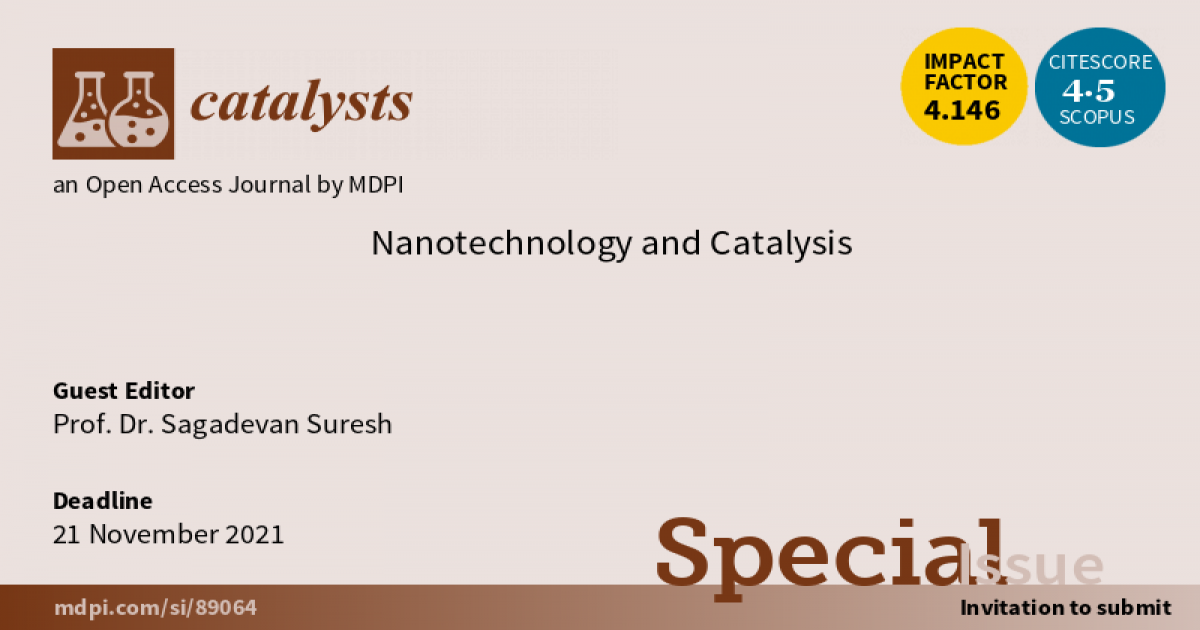Nanotechnology and Catalysis
A special issue of Catalysts (ISSN 2073-4344). This special issue belongs to the section "Nanostructured Catalysts".
Deadline for manuscript submissions: closed (21 November 2021) | Viewed by 9063

Special Issue Editor
Interests: nanomaterials; nanocomposites; photocatalysis and functional materials
Special Issues, Collections and Topics in MDPI journals
Special Issue Information
Dear Colleagues,
We have the pleasure to announce the 1st Malaysia International Conference on Nanotechnology and Catalysis in Langkawi Island, Malaysia. The 1st Malaysia International Conference on Nanotechnology and Catalysis (MICNC2021) will be held on 1–3 September 2021 at Langkawi Island, Malaysia. The conference is hosted by Nanotechnology and Catalysis Research Centre (NANOCAT), Universiti Malaya. MICNC2021 will be a great platform for researchers, academics, students, as well as practitioners from industries to engage in knowledge and technology sharing. This conference also encourages participants to exchange experiences and challenges independently. Additionally, it promotes future collaborations and knowledge transfer between participants. It includes plenary, keynote and invited speakers, oral presentations, and poster sessions on different topics.
The present Special Issue will feature the works presented at MICNC2021 that promote the linkage of nanotechnology and catalysis but is also open to general contributions from the catalysis community. Authors with expertise in any topic of catalysis are cordially invited to submit their manuscripts to this Special Issue of Catalysts. Significant full papers and review articles are very welcome. The topics of the conference will cover various aspects among the following research areas:
- Green synthesis;
- Energy, oil and gas;
- Industrial catalysis;
- Biomaterials, polymers;
- Nanocomposite, hybrid;
- Colloid, surface aspects;
- Nanocrystal, nanoparticles;
- Nano-safety, nanomedicine;
- Biofuels, biomass, biodiesel;
- Nanofluid, catalytic cracking;
- Food, agriculture, environment;
- Synthetic chemistry techniques;
- Nanoelectronics, photonics, optics;
- Catalysis processes and applications;
- Photochemistry and electrochemistry;
- Theory and simulation of nanosystem;
- Nanofabrication and characterizations;
- Chemical kinetics and catalytic activity;
- Sensing, separation, membrane reactor;
- Macrocyclic and supramolecular chemistry;
- Graphene, fullerenes, CNTs, cellulose, fiber;
- Soft matter (aerogels, foams, granular matter);
- Nanointegration, nanotribology, nanoreactors;
and other related areas in science and engineering.
More information about the conference can be found at https://umevent.um.edu.my/MICNC2021.
Scientists are cordially invited to contribute original research papers or reviews in all aspects above to this Special Issue of Catalysts.
Prof. Dr. Sagadevan SureshGuest Editor
Manuscript Submission Information
Manuscripts should be submitted online at www.mdpi.com by registering and logging in to this website. Once you are registered, click here to go to the submission form. Manuscripts can be submitted until the deadline. All submissions that pass pre-check are peer-reviewed. Accepted papers will be published continuously in the journal (as soon as accepted) and will be listed together on the special issue website. Research articles, review articles as well as short communications are invited. For planned papers, a title and short abstract (about 100 words) can be sent to the Editorial Office for announcement on this website.
Submitted manuscripts should not have been published previously, nor be under consideration for publication elsewhere (except conference proceedings papers). All manuscripts are thoroughly refereed through a single-blind peer-review process. A guide for authors and other relevant information for submission of manuscripts is available on the Instructions for Authors page. Catalysts is an international peer-reviewed open access monthly journal published by MDPI.
Please visit the Instructions for Authors page before submitting a manuscript. The Article Processing Charge (APC) for publication in this open access journal is 2200 CHF (Swiss Francs). Submitted papers should be well formatted and use good English. Authors may use MDPI's English editing service prior to publication or during author revisions.
Keywords
- Green Synthesis
- Energy
- Oil and gas
- Industrial catalysis
- Biomaterials
- Polymers
- Nanocomposite
- Hybrid
- Colloid
- Surface aspects
- Nanocrystal
- Nanoparticles
- Nanosafety
- Nanomedicine
- Biofuels
- Biomass
- Biodiesel
- Nanofluid
- Catalytic cracking
- Food
- Agriculture
- Environment
- Synthetic chemistry techniques
- Nanoelectronics
- Photonics
- Optics
- Catalysis processes and applications
- Photochemistry and electrochemistry
- Theory and simulation of nanosystem
- Nanofabrication and characterizations
- Chemical kinetics and catalytic activity
- Sensing, separation
- Membrane reactor
- Macrocyclic and supramolecular chemistry graphene
- Fullerenes
- CNTs
- Cellulose
- Fiber
- Nanointegration
- Nanotribology
- Nanoreactors
- Soft matter (aerogels, foams, granular matter)
Benefits of Publishing in a Special Issue
- Ease of navigation: Grouping papers by topic helps scholars navigate broad scope journals more efficiently.
- Greater discoverability: Special Issues support the reach and impact of scientific research. Articles in Special Issues are more discoverable and cited more frequently.
- Expansion of research network: Special Issues facilitate connections among authors, fostering scientific collaborations.
- External promotion: Articles in Special Issues are often promoted through the journal's social media, increasing their visibility.
- e-Book format: Special Issues with more than 10 articles can be published as dedicated e-books, ensuring wide and rapid dissemination.
Further information on MDPI's Special Issue polices can be found here.





